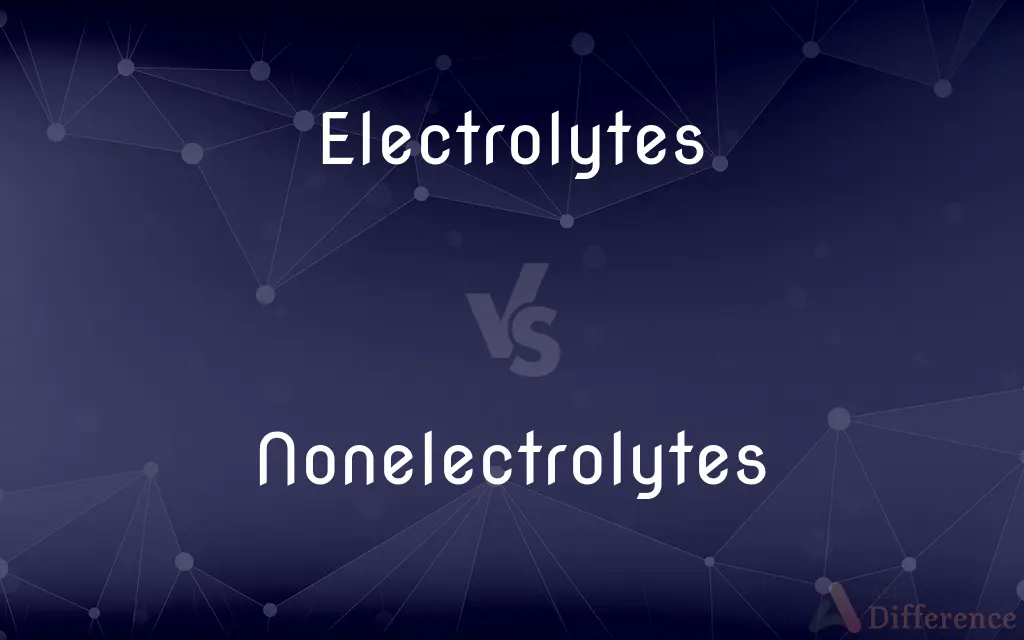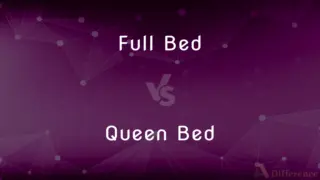Electrolytes vs. Nonelectrolytes — What's the Difference?
Edited by Tayyaba Rehman — By Fiza Rafique — Published on December 22, 2023
Electrolytes are substances that dissociate into ions in solution and conduct electricity, while Nonelectrolytes don't dissociate and remain non-conductive in solution.

Difference Between Electrolytes and Nonelectrolytes
Table of Contents
ADVERTISEMENT
Key Differences
Electrolytes are chemical compounds that, when dissolved in water, produce a solution that can conduct electricity. This electrical conductivity is attributed to the free ions present in the solution, which move under the influence of an external electric field. On the contrary, Nonelectrolytes are substances that, when dissolved, don't dissociate into ions and thus, their solutions are non-conductive.
The presence of ions is a defining characteristic of Electrolytes. These ions can be either positively charged (cations) or negatively charged (anions). When an electric current passes through an electrolytic solution, these ions move towards electrodes, resulting in the conduction of electricity. Nonelectrolytes, in contrast, don't produce any ions when they dissolve. As a result, solutions of Nonelectrolytes don't have charges available for conduction.
Electrolytes are pivotal for numerous physiological processes in the human body. They maintain the balance of fluids inside and outside cells and ensure the proper functioning of nerves, muscles, and other tissues. Nonelectrolytes, while they don't participate in electrical conduction, can have significant roles in biological systems, often acting as solvents or taking part in various chemical reactions.
In practical applications, Electrolytes are widely used in batteries and electrolytic cells, where ion movement is crucial for electricity production or chemical synthesis. Nonelectrolytes, given their non-conductive nature, aren't used in such contexts but find applications in other areas of chemistry and biology, where conductivity is not a requirement.
Comparison Chart
Ion Formation
Dissociate into ions when dissolved
Don't dissociate; remain whole in solution
ADVERTISEMENT
Conductivity
Conduct electricity in solution
Don't conduct electricity
Charge Presence
Contain free-moving positive and negative ions
Lack free-moving ions
Physiological Role
Maintain fluid balance, nerve & muscle function in body
Play roles as solvents or in chemical reactions
Applications
Used in batteries and electrolytic cells
Found in various non-conductive chemical and biological roles
Compare with Definitions
Electrolytes
Materials that can transform into carriers of electric current in a solution.
Electrolytes are crucial for the proper functioning of batteries in electronic devices.
Nonelectrolytes
Compounds that maintain their molecular integrity in a solution, without forming ions.
Ethanol is a Nonelectrolyte as it doesn't dissociate into ions in a solution.
Electrolytes
Agents that produce charged particles when mixed in a solvent, typically water.
Electrolytes in our bloodstream help regulate the balance of fluids in our body.
Nonelectrolytes
Substances that don't produce ions and remain non-conductive when dissolved.
Sugar, when dissolved in water, behaves as a Nonelectrolyte, not conducting electricity.
Electrolytes
Substances that produce ions in solution, enabling electrical conduction.
Sodium chloride becomes an Electrolyte in water, producing sodium and chloride ions.
Nonelectrolytes
Agents that don't ionize or conduct electricity in aqueous solutions.
Glycerol remains a Nonelectrolyte, even when mixed with water.
Electrolytes
Conductive solutions resulting from the dissolution and ionization of certain substances.
When people get dehydrated, they often consume Electrolytes to restore their body's ionic balance.
Nonelectrolytes
Solutions devoid of charged particles, resulting from certain substances' dissolution.
The Nonelectrolyte properties of pure distilled water make it non-conductive.
Electrolytes
Chemical compounds that dissociate to form free ions when dissolved.
In sports drinks, Electrolytes like potassium help replenish lost ions during exertion.
Nonelectrolytes
Materials that, when dissolved, don't contribute to the electric current in a solution.
Dissolving urea in water creates a solution of Nonelectrolyte nature.
Electrolytes
A chemical compound that ionizes when dissolved or incorporated in another substance, thereby producing an electrically conductive medium.
Nonelectrolytes
Plural of nonelectrolyte
Electrolytes
A solution in which such compounds are ionized.
Electrolytes
(Physiology) Any of various ions, such as sodium, potassium, or chloride, required by cells to regulate the electric charge and flow of water molecules across the cell membrane.
Electrolytes
Plural of electrolyte
Common Curiosities
What are Electrolytes?
They are substances that produce ions in solution, allowing electrical conduction.
How do Nonelectrolytes differ?
Nonelectrolytes don't produce ions and remain non-conductive when dissolved.
Can Nonelectrolytes become Electrolytes under certain conditions?
No, Nonelectrolytes inherently lack the property to dissociate into ions in solutions.
Where are Electrolytes commonly found?
In bodily fluids, sports drinks, batteries, and many chemical solutions.
Why are Electrolytes important in the human body?
Electrolytes help maintain fluid balance and ensure proper nerve and muscle function.
How are Electrolytes used in batteries?
They facilitate ion movement between electrodes, enabling electrical current production.
Why don't Nonelectrolytes produce ions in solution?
Their molecular structure doesn't allow dissociation into ions in solvents.
Do all solvents produce Electrolytes when mixed with salts?
No, it depends on the solvent's ability to facilitate ion dissociation.
Why might a doctor recommend an Electrolyte solution?
To treat dehydration and restore the body's electrolytic balance.
Can pure water act as an Electrolyte?
Pure water is a weak Electrolyte, with minimal ionization, but generally considered a Nonelectrolyte.
How can one identify Nonelectrolytes in a lab?
A solution made from a Nonelectrolyte will not conduct electricity.
Is the presence of Electrolytes necessary for all chemical reactions?
No, but they play a vital role in reactions involving ion transfer or conduction.
Do Electrolytes always produce equal numbers of positive and negative ions?
Yes, to maintain electrical neutrality in the solution.
Are all Nonelectrolytes safe to consume?
Not necessarily; their safety depends on their chemical nature, not their ionic properties.
Do Electrolytes and Nonelectrolytes have distinct boiling or freezing points?
Yes, Electrolytes often alter the boiling and freezing points of solutions more significantly than Nonelectrolytes.
Share Your Discovery

Previous Comparison
Full Bed vs. Queen Bed
Next Comparison
Demand-Pull Inflation vs. Cost-Push InflationAuthor Spotlight
Written by
Fiza RafiqueFiza Rafique is a skilled content writer at AskDifference.com, where she meticulously refines and enhances written pieces. Drawing from her vast editorial expertise, Fiza ensures clarity, accuracy, and precision in every article. Passionate about language, she continually seeks to elevate the quality of content for readers worldwide.
Edited by
Tayyaba RehmanTayyaba Rehman is a distinguished writer, currently serving as a primary contributor to askdifference.com. As a researcher in semantics and etymology, Tayyaba's passion for the complexity of languages and their distinctions has found a perfect home on the platform. Tayyaba delves into the intricacies of language, distinguishing between commonly confused words and phrases, thereby providing clarity for readers worldwide.
















































